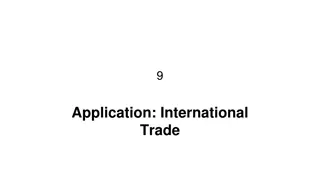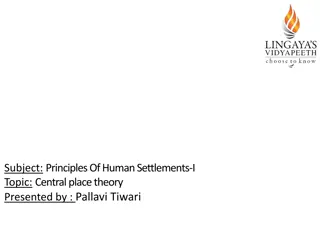Understanding Central Place Theory: Key Concepts and Determinants
Central Place Theory (CPT) attempts to explain the spatial arrangement, size, and number of settlements based on central places, zones of influence, and hinterlands. This theory, introduced by Walter Christaller in 1933, outlines the importance of central functions, threshold populations, and factors like evenly distributed resources and purchasing power. By examining determinants such as threshold populations and range of functions, CPT helps in understanding how central places are organized in relation to each other. The theory makes assumptions about terrain, population distribution, resources, purchasing power, transportation costs, and perfect competition, all of which influence the development and organization of settlements.
Download Presentation

Please find below an Image/Link to download the presentation.
The content on the website is provided AS IS for your information and personal use only. It may not be sold, licensed, or shared on other websites without obtaining consent from the author. Download presentation by click this link. If you encounter any issues during the download, it is possible that the publisher has removed the file from their server.
E N D
Presentation Transcript
By Dr. Chandana Singha Head Department of Geography B.B. College, Asansol
INTRODUCTION Central Place Theory (CPT) is an attempt to explain the spatial arrangement, size, and number of settlements. The theory was originally published in 1933 by a German geographer Walter Christaller who studied the settlement patterns in southern Germany. In the flat landscape of southern Germany Christaller noticed that towns of a certain size were roughly equidistant. By examining and defining the functions of the settlement structure and the size of the hinterland he found it possible to model the pattern of settlement locations using geometric shapes.
Central place: A Central Place is a settlement which provides one or more services for the population living around it. Zone of influence: The sphere of influence is the area under influence of the Central Place. Economic reach: This is a measure of centrality Centrality: It is crucial to the development of urban places and their service areas. Hinterland: It refers to the area surrounding a service from which consumers are drawn. Central function: Services that are performed purely for the surrounding areas are termed central functions.
DETERMINANTS OF CENTRAL PLACE Threshold Population_ Each Function needs a minimum number of customer to survive. The minimum population that can ensure this number is called its threshold population. Therefore the threshold population of a lower order function will be less than that for a higher order one. I. Range of Function_ the average maximum distance people will travel to purchase goods II. and services From these two concepts the lower and upper limits of goods or services can be found. With the upper and the lower limits, it is possible to see how the central places are arranged in an imaginary area.
ASSUMPTIONS An even (flat) terrain A hilly and uneven terrain poses difficulty in development thus a flat area which promotes the growth of the town Evenly distributed population residents are not concentrated at one particular place and no preference exists for a particular town Evenly distributed resources no place has an advantage of resources, all placed will compete under perfect market conditions Similar purchasing power along with the population and resources, wealth is also fairly distributed. Because of this people have similar purchasing power Preference for the nearest market people will buy products from the nearest market and avoid the long commute. This keeps price constant as per other assumptions Equal transportation cost (proportional to distance) the cost incurred in transporting of goods is equal for all and is proportional to the distance Perfect competition price is decided on basis of demand and supply. People will buy at the lowest price which market has to offer, no seller has an advantage over another seller.
HIERARCHY OF SETTLEMENTS CAPITAL Markets and Services tend to be nested hierarchies smaller towns smaller markets. However, transportation and border effects can distribution of towns away from theoretical uniformity. with serving CITY shift the LARGE TOWNS SMALL TOWNS VILLAGE HAMLET
ARRANGEMENTS OF CENTRAL PLACES Circular shape of the market areas results in either un- served areas over-served areas. To solve this problem, Christaller suggested the hexagonal shape of the markets as shown in D in the above diagram. or
THREE PRINCIPLES FOR ARRANGEMENTS OF CENTRAL PLACES 1.The marketing principle (K=3 system) 2. The transportation principle (K=4 system); 3. The administrative principle (K=7 system).
MARKETING PRINCIPLE Marketing Principle (K=3): As per this the market area of a higher order occupies one-third (1/3 part) of the market area of each of the consecutive lower size place(node) which lies on its neighbor. The lower size nodes (6 in numbers and 2nd larger circles) are located at the corner of the largest hexagon around the high-order settlement. Each high-order settlement gets 1/3rd of each satellite settlement (which are 6 in total), thus K = 1 + 6 1/3 = 3. With K=3 the transport network is not efficient even when the distance traveled is reduced. This is because of the absence of transport links (network) between the larger places (nodes).
TRANSPORT PRINCIPLE Transport Principle (K=4): This provides for most efficient transport network. High order place half of the market area of 6 neighboring lower order places located on the edge of the hexagon formed by high order settlement. There are maximum central places possible. These are located on the main transport routes connecting the higher order center. The transportation principle involves the minimization of the length of roads connecting central places at all hierarchy levels. In this system of nesting, the lower order centers are all located along the roads linking the higher order centers. This alignment of places along a road leads to minimization of road length. However, for each higher order center, there are now four centers of immediate lower order, as opposed to three centers under the marketing principle.
ADMINISTRATIVE PRINCIPLE Administrative Principle (K=7): According to K = 7 administrative principle (or political-social principle), settlements are nested according to sevens. The market areas of the smaller settlements are completely enclosed within the market area of the larger settlement. Since tributary areas cannot be split administratively, they must be allocated exclusively to a single higher-order place. Efficient administration is the control principle in this hierarchy.
EVALUATION The pattern of cities predicted by central place theory may not hold because of the failure to meet initial assumptions. Production costs may vary not only because of economies of scale but also by natural resource endowments (i.e. not a homogeneous plain). 1. Transportation costs are not equal in all directions. 2. Rural markets (initially households) are not evenly distributed. 3. Non economic factors (culture, politics, leadership) may be important but not evenly distributed. 4. Competitive practices may lead to freight absorption and phantom freight (other forms of imperfect competition). 5.























